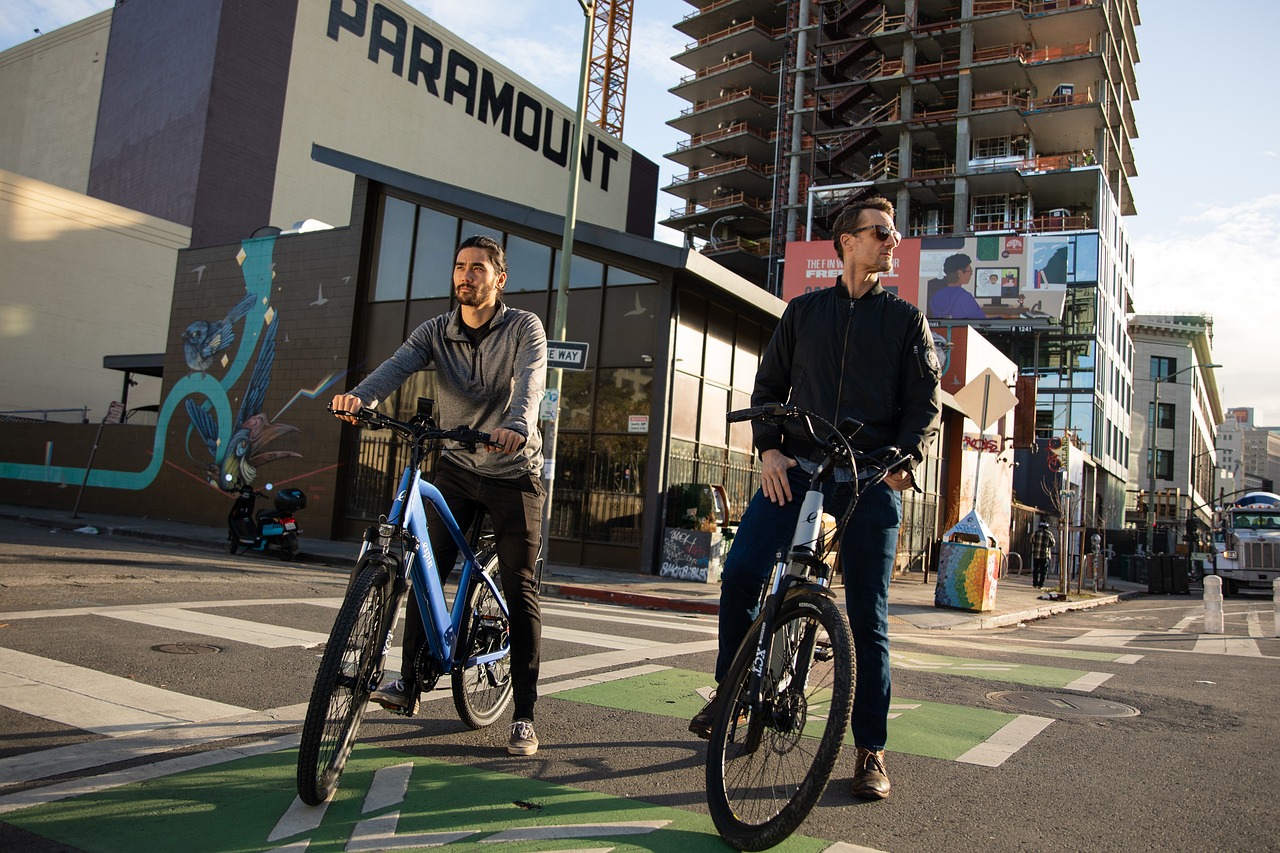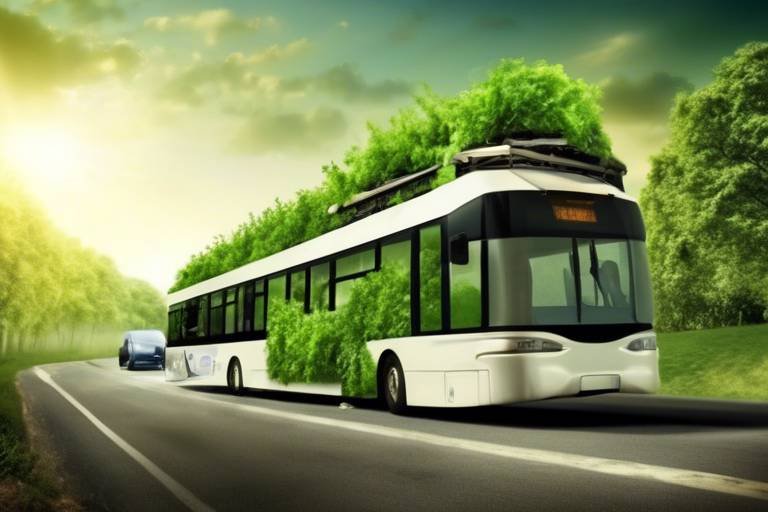The Benefits of Eco-Friendly Transportation
Exploring the benefits of eco-friendly transportation unveils a myriad of advantages that go beyond just reducing carbon emissions. By embracing environmentally sustainable modes of transportation, individuals and communities can make a significant impact on various aspects of society and the environment.
Switching to eco-friendly transportation options, such as electric vehicles and bicycles, plays a crucial role in the reduction of air pollution. These alternatives help decrease harmful emissions, thereby improving air quality and reducing health risks associated with pollution exposure. Imagine breathing in cleaner, fresher air as you commute to work or explore your city.
Furthermore, the shift towards eco-friendly transportation methods leads to a decrease in greenhouse gas emissions. By opting for sustainable modes of travel, individuals contribute to the fight against climate change and global warming. Lowering the carbon footprint of transportation systems is a vital step towards a more sustainable future for our planet.
Encouraging the use of eco-friendly transportation modes, such as walking and cycling, not only benefits the environment but also promotes public health. These activities foster physical activity, leading to improved cardiovascular health, reduced obesity rates, and enhanced overall well-being in communities. Picture a community where people are not only environmentally conscious but also physically active and healthy.
Moreover, eco-friendly transportation options, like public transit and carpooling, play a significant role in conserving energy resources. By maximizing vehicle occupancy and reducing the overall energy consumption associated with individual vehicle usage, these methods help in the efficient use of energy. It's like carpooling with friends not only saves money but also reduces energy waste.
Adopting eco-friendly transportation practices contributes to sustainable development goals by creating a more efficient and equitable transportation system. This system meets the needs of current generations without compromising the ability of future generations to meet their own needs. It's about building a transportation infrastructure that stands the test of time and benefits all members of society.
Implementing eco-friendly transportation solutions, such as pedestrian-friendly infrastructure and efficient public transit systems, enhances urban livability. By making cities more vibrant, attractive, and livable, these initiatives improve the quality of urban environments for residents and visitors alike. Imagine strolling down a bustling, pedestrian-friendly street lined with green spaces and public art installations.
Choosing eco-friendly transportation options not only benefits individuals but also society as a whole through cost savings. Reduced fuel expenses, maintenance costs, and healthcare expenditures related to air pollution lead to significant savings for individuals. This, in turn, lowers healthcare and infrastructure costs for society, creating a win-win situation for all.
Investing in eco-friendly transportation initiatives promotes social equity by providing accessible and affordable transportation options for all members of society. Regardless of income level, individuals can access sustainable modes of transportation, reducing disparities in mobility and improving overall transportation equity. It's about ensuring that everyone has equal opportunities to move around and access essential services.
Shifting towards eco-friendly transportation strategies enhances communities' resilience to climate change impacts. By reducing vulnerability to extreme weather events, improving energy efficiency, and fostering sustainable urban planning practices, these strategies pave the way for a more resilient future. It's like building a strong foundation that can withstand the challenges of a changing climate.

Reduction of Air Pollution
Exploring the advantages of using environmentally sustainable modes of transportation, such as reducing air pollution, decreasing greenhouse gas emissions, promoting public health, conserving energy, and mitigating climate change.
Switching to eco-friendly transportation options like electric vehicles and bicycles helps decrease harmful emissions, improving air quality and reducing health risks associated with pollution exposure. By choosing to travel in vehicles that produce fewer pollutants, individuals can contribute to creating cleaner and healthier environments for themselves and future generations.

Decrease in Greenhouse Gas Emissions
Exploring the advantages of using environmentally sustainable modes of transportation, such as reducing air pollution, decreasing greenhouse gas emissions, promoting public health, conserving energy, and mitigating climate change.
Switching to eco-friendly transportation options like electric vehicles and bicycles helps decrease harmful emissions, improving air quality and reducing health risks associated with pollution exposure. By utilizing these environmentally friendly methods, we can significantly lower carbon emissions, playing a crucial role in combating climate change and global warming. This reduction in greenhouse gas emissions contributes to a healthier environment and a more sustainable future for generations to come.

Promotion of Public Health
When it comes to the promotion of public health, eco-friendly transportation plays a crucial role in encouraging physical activity and improving overall well-being. By shifting towards sustainable modes of transportation like walking and cycling, individuals not only reduce their carbon footprint but also engage in regular exercise, leading to numerous health benefits.
Walking and cycling are not just means of getting from point A to point B; they are forms of exercise that can help combat sedentary lifestyles and contribute to better cardiovascular health. The simple act of walking or biking to work or running errands can significantly increase physical activity levels, reducing the risk of chronic diseases such as heart disease, diabetes, and obesity.
Furthermore, promoting active transportation options like walking and cycling creates opportunities for communities to design urban spaces that prioritize pedestrians and cyclists, making streets safer and more inviting for physical activity. This shift towards human-powered modes of transportation not only reduces air pollution and greenhouse gas emissions but also fosters a culture of health and well-being.
Research has shown that individuals who regularly engage in active transportation have lower rates of obesity and related health issues. By incorporating walking and cycling into daily routines, people can improve their overall fitness levels, mental well-being, and quality of life. The promotion of public health through eco-friendly transportation is not just about reducing pollution; it's about creating healthier, happier communities for everyone.

Conservation of Energy
Conservation of energy is a key benefit of adopting eco-friendly transportation options. By utilizing modes of transportation that prioritize energy efficiency, such as public transit and carpooling, we can significantly reduce the overall energy consumption associated with individual vehicle usage. These methods maximize vehicle occupancy, leading to a more efficient use of energy resources and a decrease in the environmental impact of transportation systems.

Contribution to Sustainable Development
Exploring the advantages of using environmentally sustainable modes of transportation, such as reducing air pollution, decreasing greenhouse gas emissions, promoting public health, conserving energy, and mitigating climate change.
Embracing eco-friendly transportation practices plays a pivotal role in contributing to sustainable development goals. By prioritizing environmentally conscious modes of transportation, communities can foster a more efficient and equitable transportation system that meets the needs of current generations without compromising the ability of future generations to meet their own needs. This shift towards sustainability ensures that resources are utilized responsibly and that transportation infrastructure is developed in a way that minimizes negative impacts on the environment and society.
Below are some common questions related to eco-friendly transportation:
- How can I incorporate eco-friendly transportation into my daily routine?
- Are eco-friendly transportation methods cost-effective?
- What are the environmental benefits of eco-friendly transportation?
- How can eco-friendly transportation promote social equity?
Consider options such as walking, cycling, using public transit, carpooling, or investing in an electric vehicle to reduce your carbon footprint.
While there may be initial investment costs, eco-friendly transportation options often lead to long-term savings through reduced fuel expenses, maintenance costs, and healthcare expenditures.
Eco-friendly transportation helps reduce air pollution, decrease greenhouse gas emissions, conserve energy, and promote sustainable urban development, contributing to a healthier planet.
By providing accessible and affordable transportation options for all members of society, regardless of income level, eco-friendly transportation initiatives help reduce disparities in mobility and improve overall transportation equity.

Enhancement of Urban Livability
When it comes to enhancing urban livability, eco-friendly transportation plays a crucial role in transforming cities into more sustainable and enjoyable spaces for residents and visitors alike. Imagine a city where bustling streets are not filled with honking cars and thick smog but instead with the sounds of pedestrians strolling along tree-lined pathways and cyclists breezing past picturesque parks. This vision of urban life is not just a dream but a tangible reality achievable through the adoption of sustainable transportation practices.
By prioritizing pedestrian-friendly infrastructure, cities can create inviting spaces that encourage people to walk, jog, or simply enjoy a leisurely stroll, promoting physical activity and fostering a sense of community engagement. Imagine wide sidewalks adorned with benches and greenery, inviting individuals to pause, interact, and savor the urban landscape. Such initiatives not only improve public health by promoting active lifestyles but also contribute to a vibrant urban environment where people feel connected to their surroundings.
Efficient public transit systems are another cornerstone of enhancing urban livability. Picture a network of buses, trams, and trains seamlessly connecting different parts of the city, offering residents a convenient, affordable, and eco-friendly alternative to private car ownership. By reducing traffic congestion and parking demands, public transit not only improves air quality but also enhances the overall mobility of urban dwellers, making it easier for them to access jobs, schools, and recreational facilities.
Furthermore, the integration of cycling infrastructure, such as dedicated bike lanes and bike-sharing programs, not only promotes sustainable transportation but also adds a sense of dynamism and energy to urban spaces. Picture cyclists weaving through traffic-free lanes, enjoying a safe and scenic commute to work or leisure destinations. Cycling not only reduces carbon emissions but also contributes to a more active and vibrant urban culture, where people of all ages and backgrounds can participate in the joys of two-wheeled travel.
In essence, the enhancement of urban livability through eco-friendly transportation is not just about reducing pollution or cutting carbon emissions; it is about creating cities that prioritize the well-being and happiness of their residents. By investing in sustainable transportation solutions, cities can become more than concrete jungles; they can evolve into green, inclusive, and thriving hubs of human activity, where the quality of life is elevated, and the spirit of community flourishes.

Cost Savings for Individuals and Society
Exploring the advantages of using environmentally sustainable modes of transportation, such as reducing air pollution, decreasing greenhouse gas emissions, promoting public health, conserving energy, and mitigating climate change.
When individuals opt for eco-friendly transportation options, they not only contribute to a healthier environment but also enjoy significant cost savings. By choosing alternatives like public transit, cycling, or carpooling, individuals can reduce their fuel expenses, maintenance costs, and healthcare expenditures related to air pollution. These savings not only benefit individuals by putting more money back in their pockets but also have a positive impact on society as a whole. Lower healthcare costs and reduced infrastructure expenses contribute to overall economic well-being, making eco-friendly transportation a win-win solution for both individuals and society.

Promotion of Social Equity
Investing in eco-friendly transportation initiatives plays a crucial role in promoting social equity within communities. By offering accessible and affordable transportation options to all members of society, regardless of their income level, eco-friendly transportation helps reduce disparities in mobility and enhances overall transportation equity. This approach aims to ensure that everyone has the opportunity to access transportation services efficiently and affordably, contributing to a more inclusive and equitable society.

Resilience to Climate Change
Exploring the advantages of using environmentally sustainable modes of transportation, such as reducing air pollution, decreasing greenhouse gas emissions, promoting public health, conserving energy, and mitigating climate change.
Embracing eco-friendly transportation strategies plays a pivotal role in enhancing communities' resilience to the adverse impacts of climate change. By transitioning towards sustainable transportation methods, cities and regions can effectively reduce their vulnerability to extreme weather events and other climate-related challenges. This shift not only improves energy efficiency but also fosters the adoption of sustainable urban planning practices, creating a more resilient infrastructure that can withstand the challenges posed by a changing climate.
Q: How can eco-friendly transportation benefit individuals and society?
A: Eco-friendly transportation options offer significant cost savings for individuals through reduced fuel expenses, maintenance costs, and healthcare expenditures related to air pollution. This not only benefits individuals but also society as a whole by lowering healthcare and infrastructure costs.
Q: How does eco-friendly transportation contribute to sustainable development?
A: Adopting eco-friendly transportation practices supports sustainable development goals by creating a more efficient and equitable transportation system that meets the needs of current generations without compromising the ability of future generations to meet their own needs.
Q: What are some examples of eco-friendly transportation methods?
A: Examples include electric vehicles, bicycles, public transit, carpooling, walking, and cycling, all of which contribute to reducing air pollution, greenhouse gas emissions, and energy consumption associated with transportation.
Q: How does eco-friendly transportation promote social equity?
A: Investing in eco-friendly transportation initiatives promotes social equity by providing accessible and affordable transportation options for all members of society, regardless of income level. This helps reduce disparities in mobility and improves overall transportation equity.
Q: What role does eco-friendly transportation play in urban livability?
A: Implementing eco-friendly transportation solutions enhances urban environments by creating pedestrian-friendly infrastructure and efficient public transit systems. This improves the quality of urban spaces, making cities more livable, vibrant, and attractive for residents and visitors.
Frequently Asked Questions
- What are the main benefits of eco-friendly transportation?
Eco-friendly transportation offers a range of benefits, including reducing air pollution, decreasing greenhouse gas emissions, promoting public health, conserving energy, contributing to sustainable development, enhancing urban livability, saving costs for individuals and society, promoting social equity, and increasing resilience to climate change.
- How does eco-friendly transportation help in reducing air pollution?
Eco-friendly transportation options like electric vehicles and bicycles produce fewer harmful emissions, leading to improved air quality and reducing health risks associated with pollution exposure. By choosing sustainable modes of transportation, we can significantly decrease the levels of pollutants in the air.
- Can eco-friendly transportation methods save money for individuals and society?
Absolutely! Opting for eco-friendly transportation can result in substantial cost savings for both individuals and society as a whole. By reducing fuel expenses, maintenance costs, and healthcare expenditures related to air pollution, eco-friendly transportation not only benefits our wallets but also contributes to lower healthcare and infrastructure costs for society.



















